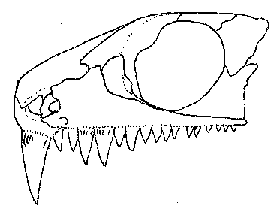 W
WAcleistorhinidae is an extinct family of Late Carboniferous and Early Permian-aged lanthanosuchoid parareptiles. Presently, the clade consists of only three taxa: Colobomycter and Acleistorhinus, both collected from the Permian of Oklahoma, and Carbonodraco from the Carboniferous of Ohio. Sister taxa include Chalcosaurus, Lanthaniscus and Lanthanosuchus.
 W
WAnthodon is an extinct genus of pareiasaurid parareptile from the Permian period of South Africa and Tanzania.
 W
WAraeoscelis is an extinct genus of reptile, and one of the earliest diapsids. Fossils have been found in the Nocona, Arroyo and Waggoner Ranch Formations in Texas, dating to the Early Permian. Two species have been described, A. casei and A. gracilis.
 W
WArchosaurus is an extinct genus of carnivorous archosauriform reptile. From the latest Permian of Russia and Poland, it is one of the earliest known archosauriforms. The type and only species is Archosaurus rossicus, known from several fragmentary specimens which cumulatively represent parts of the skull and cervical vertebrae.
 W
WArganaceras is a medium-sized pareiasaur from the Late Permian Ikakern Formation of Morocco. It was about 2 metres (6.6 ft) in length and had a horn-like structure on its snout.
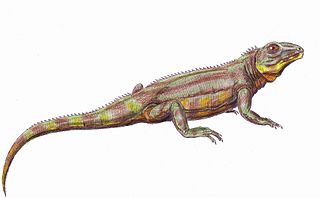 W
WBelebey is an extinct genus of bolosaurid ankyramorph parareptile containing species known from the latest Carboniferous (Gzhelian) or earliest Permian (Asselian) to Guadalupian stage of Europe and Asia (China).
 W
WBolosauridae is an extinct family of ankyramorph parareptiles known from the latest Carboniferous (Gzhelian) or earliest Permian (Asselian) to the early Guadalupian epoch of North America, China, Germany, Russia and France. The bolosaurids were unusual for their time period by being bipedal, the oldest known tetrapods to have been so. Their teeth suggest that they were herbivores. The bolosaurids were a rare group and died out without any known descendants. The following cladogram shows the phylogenetic position of the Bolosauridae, from Johannes Müller, Jin-Ling Li and Robert R. Reisz, 2008.
 W
WBolosaurus is an extinct genus of bolosaurid ankyramorph parareptile from the Cisuralian epoch of North Asia and North America.
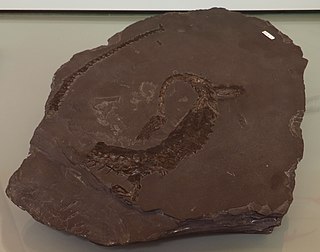 W
WBrazilosaurus is an extinct genus of mesosaur which lived during the early Permian of what is now Brazil. It is known from a skeleton recovered from the Assistencia Member of the Irati Formation, in the Paraná Basin. It was named by T. Shikama and H. Ozaki in 1966 and the type species is Brazilosaurus sanpauloensis.
 W
WDeltavjatia was a procolophonoid reptile from the Tatarian stage of the Permian time period. It had a large body of about 1.5 m (4.9 ft) in length. Deltavjatia was an herbivore and lived in what is now Russia. The first specimen of Deltavjatia was a specimen of a skull and lower mandible, found in the Urpalov Formation in Kotelnich, Vyatka River.
 W
WEudibamus is an extinct genus of biped bolosaurid ankyramorph parareptile known from the Free State of Thuringia of central Germany. It had a very small size reaching only 25 cm in length.
 W
WHovasaurus is an extinct genus of diapsid reptile belonging to the order Eosuchia. It lived in what is now Madagascar during the Late Permian and Early Triassic, being a survivor of the Permian–Triassic extinction event and the paleontologically youngest member of the Tangasauridae. Fossils have been found in the Permian Lower and Triassic Middle Sakamena Formations of the Sakamena Group.
 W
WLabidosaurus is an extinct genus of anapsid reptile from the Permian period of North America. Fossils have been discovered in Texas.
 W
WLanthanosuchoidea is an extinct superfamily of ankyramorph parareptiles from the middle Pennsylvanian to the middle Guadalupian epoch of Europe, North America and Asia. It was named by the Russian paleontologist Ivachnenko in 1980, and it contains two families Acleistorhinidae and Lanthanosuchidae.
 W
WLanthanosuchus is an extinct genus of parareptile from the Late Permian. It was found at Isheevo in Tatarstan. Lanthanosuchus had a length of 75 cm.
 W
WMillerettidae is an extinct family of parareptiles from the Middle Permian to the Late Permian period of South Africa. The millerettids were small insectivores and probably resembled modern lizards in appearance and lifestyle.
 W
WMillerosaurus is an extinct genus of millerettid parareptile from the Late Permian of South Africa. It was a small animal which reached a length of 30 cm. Unlike many other parareptiles, it had holes (fenestrae) behind the eyesockets in the skull. It had a slabsided body, a long tail, and a narrow but triangular skull with large eyes, and is thought to have been insectivorous.
 W
WNanoparia is an extinct genus of pareiasaur that lived in the Permian.
 W
WOrovenator is an extinct genus of diapsid from Lower Permian deposits of Oklahoma, United States. It is known from two partial skulls from the Richards Spur locality in Oklahoma. The holotype OMNH 74606 consists of a partial skull preserving snout and mandible, and the referred specimen, OMNH 74607, a partial skull preserving the skull roof, vertebrae and palatal elements. It was first named by Robert R. Reisz, Sean P. Modesto and Diane M. Scott in 2011 and the type species is Orovenator mayorum. The generic name means "mountain", oro, in Greek in reference to the Richards Spur locality, which was mountainous during the Permian period and "hunter", venator, in Latin. The specific name honours Bill and Julie May. Orovenator is the oldest and most basal neodiapsid to date.
 W
WPaliguana is an extinct genus of lizard-like lepidosauromorph reptile from the Late Permian or Early Triassic Katberg Formation in the upper Lystrosaurus Assemblage Zone of South Africa.
 W
WPareiasaurus is an extinct genus of anapsid reptile from the Permian period. It was a typical member of its family, the pareiasaurs, which take their name from this genus.
 W
WProtorothyris is an extinct genus of Early Permian protorothyridid known from Texas and West Virginia of the United States. It was first named by Llewellyn Ivor Price in 1937 and the type species is Protorothyris archeri. P. archeri is known from the holotype MCZ 1532, a three-dimensionally preserved skull and from the referred specimens, which come from four additional individuals, MCZ 2147-2150. All specimens were collected in the Cottonwood Creek site, from the Archer City Formation, Texas, dating to the Asselian stage of the Cisuralian epoch, about 299–294.6 million years ago. A second species, P. morani, was first named by Alfred Sherwood Romer in 1952 with its own generic name, Melanothyris. In 1973, J. Clark and Robert L. Carroll recombined P. morani as a Protorothyris species. It is known from the holotype CM 8617, a three-dimensionally preserved skull. It was collected in the Blacksville site, from the Washington Formation of West Virginia. Protorothyris was the size of the average lizard, about 30 cm in length.
 W
WPumiliopareia is an extinct genus of pareiasaurid parareptile from the Permian period of South Africa.It is known from a complete skeleton with osteoderms.
 W
WPumiliopareiasaurians are a group of pareiasaurid reptiles.
 W
WShihtienfenia was a pareiasaurid from the Late Permian of China.
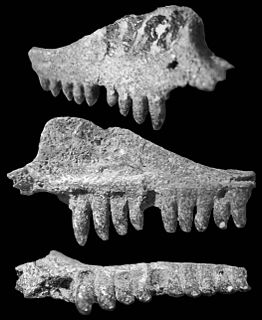 W
WSuchonosaurus is an extinct genus of procolophonid reptile from the Late Permian of Russia. It is monotypic, including the species Suchonosaurus minimus, which is itself known only from a single fragment of the upper jaw. Suchonosaurus is currently considered the oldest member of the family Procolophonidae, as it is the only procolophonid known from the Permian period.
 W
WTangasauridae is a family of eosuchian diapsids. Specimens have been found that are of Late Permian to Early Triassic in age from the Sakamena Group of western Madagascar. They lived alongside other taxa present from the Sakamena Group, including temnospondyls, rhynchosaurs, and gomphodont eucynodonts. Fossils have been found of numerous specimens of common members of this family such as Hovasaurus and Thadeosaurus in different stages of ontogenic development. Recent material from the Middle Sakamena Formation of the Morondava Basin of Madagascar that dates back to the early Triassic period suggests that the Tangasauridae were relatively unaffected by the Permian-Triassic extinction event.
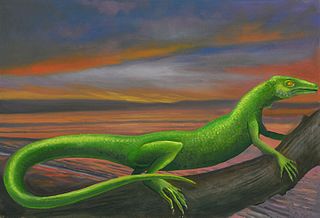 W
WThadeosaurus is an extinct genus of diapsid reptile belonging to the family Younginidae. Fossils have been found in the Lower Sakamena Formation of the Morondava Basin, Madagascar in 1981, and date to the late Permian to the early Triassic period.
 W
WWeigeltisaurus is an extinct genus of weigeltisaurid reptile from the Late Permian of Germany and England. It has a single species, originally named as Palaechamaeleo jaekeli in 1930 and later assigned the name Weigeltisaurus jaekeli in 1939, when it was revealed that Palaeochamaeleo was a preocuppied name. A 1987 review by Evans and Haubold later lumped Weigeltisaurus jaekeli under Coelurosauravus as a second species of that genus. A 2015 reassessment of skull morphology study substantiated the validity of Weigeltisaurus and subsequent authors have used this genus.
 W
WYounginiformes is a replacement name for the taxon Eosuchia, proposed by Alfred Romer in 1947.